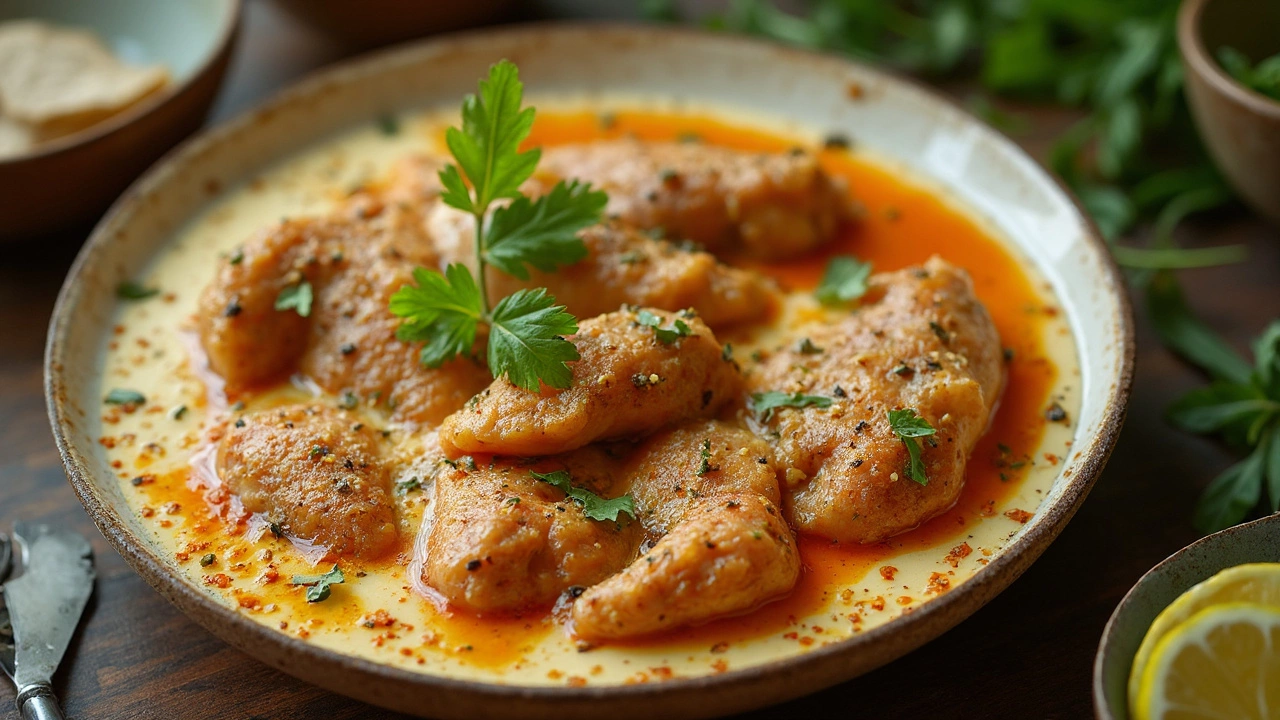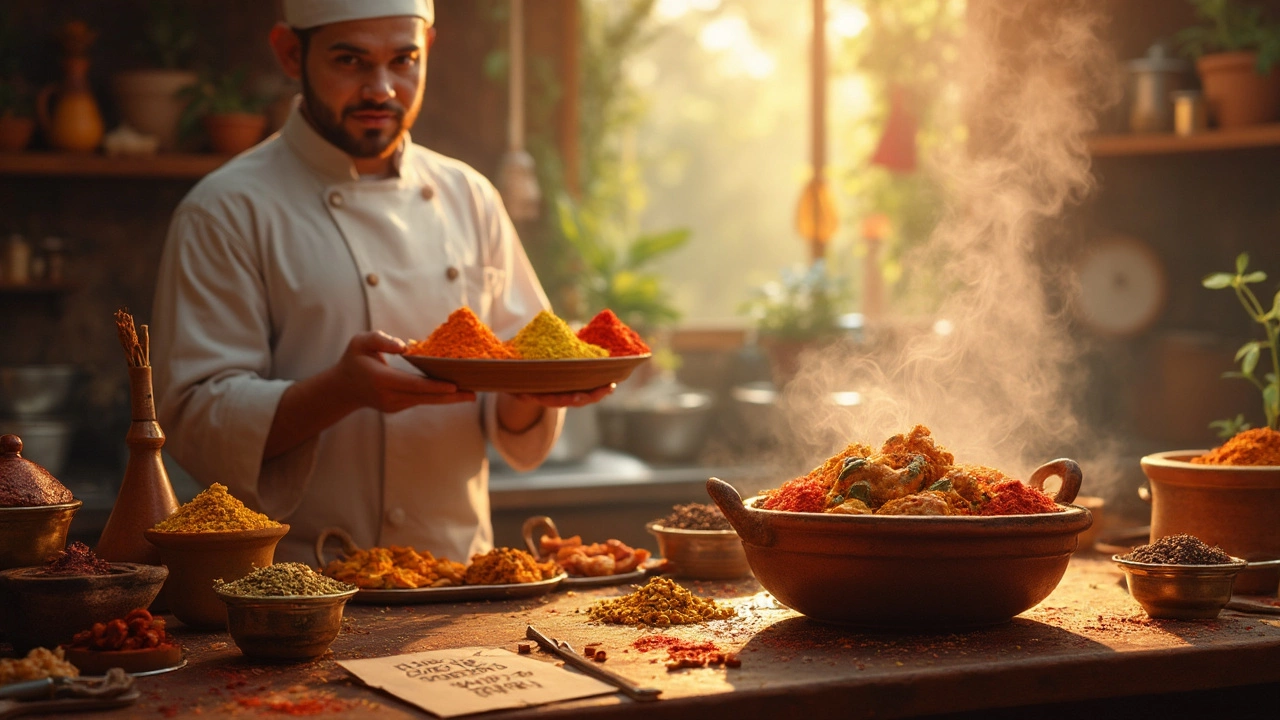So, what makes a chicken curry go from just okay to absolutely mouth-watering? First things first: it's all about the spices. Sure, a basic curry powder can do the job, but why not explore individual spices like cumin, coriander, or turmeric? They bring a depth of flavor you just can't get from a pre-mixed packet.
Another game changer? Marinating your chicken before cooking. Giving the meat some time to absorb those spices ensures they're not just a coating on the surface, but infuse throughout. Plus, if you toss in a bit of yogurt or lemon juice, you'll tenderize the chicken while boosting flavor.
- Essential Spices
- Marination Magic
- Cooking Techniques
- Adding Depth with Broth
- Balancing Flavors
- Garnishing Tips
Essential Spices
Diving into the world of chicken curry, there's one golden rule: never underestimate the power of spices. They are the backbone of any great chicken curry. Using quality, fresh spices can make an extraordinary difference in taste.
Cumin and Coriander: The Dynamic Duo
These two are often paired together for a reason. Cumin brings a warm, earthy dimension, while coriander adds a slight sweetness. Both are essential for delivering that authentic curry flavor, and when fried in oil at the start, their aromas get a chance to really bloom.The Kick of Turmeric
Often used for its vibrant yellow color, turmeric also adds a subtle peppery taste. It's a staple in many curry powders and freshens up the dish while providing some health benefits, given its anti-inflammatory properties.Choosing Your Heat: Chili Options
Whether it's fresh chilies, chili powder, or flakes, the type you choose will affect your chicken curry drastically. For a more intense heat, consider options like bird's eye chili; if you prefer something milder, go for Kashmiri chili powder, known for its color rather than heat.Here's a quick rundown to help balance your spices:
- Cumin: 1-2 teaspoons
- Coriander: 1-2 tablespoons
- Turmeric: 1/2 teaspoon
- Chili: Adjust to taste
Using whole spices can amplify flavors. For an added punch, try toasting them lightly before grinding. And remember, always store spices in a cool, dry place to preserve their potency. There you have it—this knowledge sets the stage for a delicious chicken curry that's anything but ordinary.
Marination Magic
Let's dive into why marinating is a crucial step for making a chicken curry that's bursting with flavor. Simply put, marinating helps break down proteins, allowing the chicken to become more tender and absorb all those incredible spices. It's not just a surface-level treatment; the right marinade gets deep into the meat.
Getting Started with the Basics
When you're ready to marinate, you'll need a combo of yogurts, citrus juices, and spices. Yogurt is a fantastic base as it not only tenderizes but also helps the flavors stick. Acidic elements like lemon juice can work wonders, too.
The Perfect Marinade
Here's a simple yet effective mixture:
- 1 cup of plain yogurt
- 2 tablespoons of lemon juice
- 1 tablespoon of ground cumin
- 1 tablespoon of ground coriander
- 1 teaspoon of turmeric
- 1 teaspoon of salt
- A pinch of cayenne for a bit of heat
Mix these together and massage them into your chicken pieces. Ideally, let it sit in the fridge for at least 2 hours. Need a time hack? Even 30 minutes can make a noticeable difference.
Marination Time & Results
How long should you marinate? It depends. A couple of hours are usually enough, but if you're planning ahead, leaving it overnight guarantees deeper flavor. Just don't leave it longer than 24 hours, or you might end up with a mushy texture.
If you're curious about how much of a difference this method makes, consider the stats: a well-marinated chicken can increase flavor penetration by up to 30% compared to one that isn't marinated.
So next time you're prepping your chicken curry, don't skip out on the marination magic. It's the secret ingredient to making your dish a standout.
Cooking Techniques
When it comes to cooking the perfect chicken curry, how you cook it is just as important as what's in it. Let's talk heat. Start with a medium-high heat to sauté onions and spices so they can release their natural oils and aromas. This step is crucial to unlocking the flavors that make your curry unforgettable.
Sautéing Right
Sautéing is more than just a quick fry. It’s where magic happens. Make sure your onions are golden brown before you move on to the next steps. This ensures that your base is flavorful.
The Simmer Game
Once you've combined your spices and added the chicken, it's time to let things simmer. Lower the heat to medium or even low. This allows the flavors to meld over time, making your chicken tender and the sauce rich. Patience is your best friend here.
Heat Control and Consistency
Consistency is key. Stir occasionally to avoid sticking, ensuring each piece of chicken is submerged and soaking up the sauce while preventing anything from burning. If the sauce is too thick, a splash of broth can adjust it to your liking.
Secret Tips
Want a thicker sauce? Blend a few cooked ingredients and return them to the pot. Need more depth? Add a hint of coconut milk or cream in the last few minutes.
| Techniques | Benefits |
|---|---|
| Sautéing | Releases spice and onion flavors |
| Simmering | Makes chicken tender, melds flavors |
| Heat Control | Prevents burning, ensures even cooking |

Adding Depth with Broth
Ever wondered why some chicken curries taste more luscious than others? The secret might just be in the broth. You see, while water can be used to create the base, using a flavorful broth can elevate your curry game drastically. The difference is in the depth and richness it brings.
When you're crafting a chicken curry, consider swapping out plain water for a well-prepared chicken or vegetable broth. This switch immediately infuses your dish with an extra layer of flavor right from the get-go. If you're using a homemade broth, even better! You can control the sodium and seasoning to perfectly suit your curry.
Homemade vs. Store-bought Broth
Homemade broths are fantastic because they allow you to use leftover chicken bones and vegetable scraps, transforming waste into taste. But, let's be real, not everyone has the time to simmer a pot for hours. That's where a quality store-bought broth can do the trick. Just check those ingredients lists for any unwanted additives.
Flavor Boosters
Boosting broth flavor is easy. Adding a bay leaf or two, a few peppercorns, or even a couple of slices of ginger can enhance and complement the chicken curry flavor profile. As the curry cooks and simmers, these elements release their essence, mingling beautifully with the spices.
If you're someone who likes a bit of creaminess, try incorporating some coconut milk into your broth mix. This doesn't just add richness, but also brings that classic Southeast Asian twist to your dish.
| Broth Type | Key Benefit |
|---|---|
| Chicken Broth | Rich in flavor, enhances savory notes |
| Vegetable Broth | Light and versatile, adds subtle depth |
| Coconut Milk | Adds creaminess, complements spices |
Finally, remember that good broth takes your chicken curry from amateur hour to professional in just one swap. So next time you're whipping up that chicken curry, give some serious thought to what's going into your pot!
Balancing Flavors
Ever wondered why some chicken curry dishes just hit differently? It often boils down to the art of balancing flavors. A good curry doesn’t just rely on spices; it’s about getting that perfect harmony between sweetness, saltiness, tanginess, and heat.
Understanding the Flavor Profile
Think of flavors as a see-saw. If one side is too heavy, the whole dish gets off-balance. For instance, if your curry is too spicy, a touch of sweetness like sugar or honey might help balance it out. Similarly, a squeeze of lemon or a splash of vinegar can work wonders if it's too rich or heavy.
Key Balancing Ingredients
Here are some kitchen staples to keep in mind when you're looking to enhance your curry:
- Sugar or Honey: These can mellow out overly spicy or tangy notes.
- Lemon Juice or Vinegar: Great for cutting through richness and providing freshness.
- Salt: A small amount can bring out other flavors and fix blandness.
"A good curry balances sweetness, saltiness, tanginess, and spice," says Sara Ahmed, a renowned spice expert.
Tips to Remember
Don’t be afraid to experiment with these elements. Taste as you go, and adjust the seasoning in small amounts. Remember, you can always add more, but you can't take it out once it's in there.
If you're a fan of stats, studies suggest that people prefer a slight balance towards sweetness in most cuisines, but this can be a matter of personal preference.
Garnishing Tips
Alright, so you've whipped up a killer chicken curry. But before you dig in, let's talk garnishing—it's like the cherry on top of your culinary masterpiece. Think about adding a pop of color and a burst of fresh flavor. Cilantro or mint leaves are absolute legends in this department. A sprinkle on top? Chef's kiss.
Not into herbs? No worries, try thinly sliced red onions or even some fried shallots. These not only add crunch but also a sweet-savory finish that can take your curry to the next level.
Going Nuts?
Nuts can be a fantastic garnish too. Toasted almonds or cashews do wonders for texture. Just a handful can add that extra layer of wow.
Bring the Heat
If you're into a bit of heat, finely sliced chili peppers are your best friend. You can mix and match here—green for a fresh kick, or red if you're feeling bold. Just be cautious about the spice level if you're serving a crowd!
So next time you make chicken curry, don't skip the garnish. A little goes a long way in making your dish stand out, both in looks and in taste. Trust me, it's worth the extra step.
